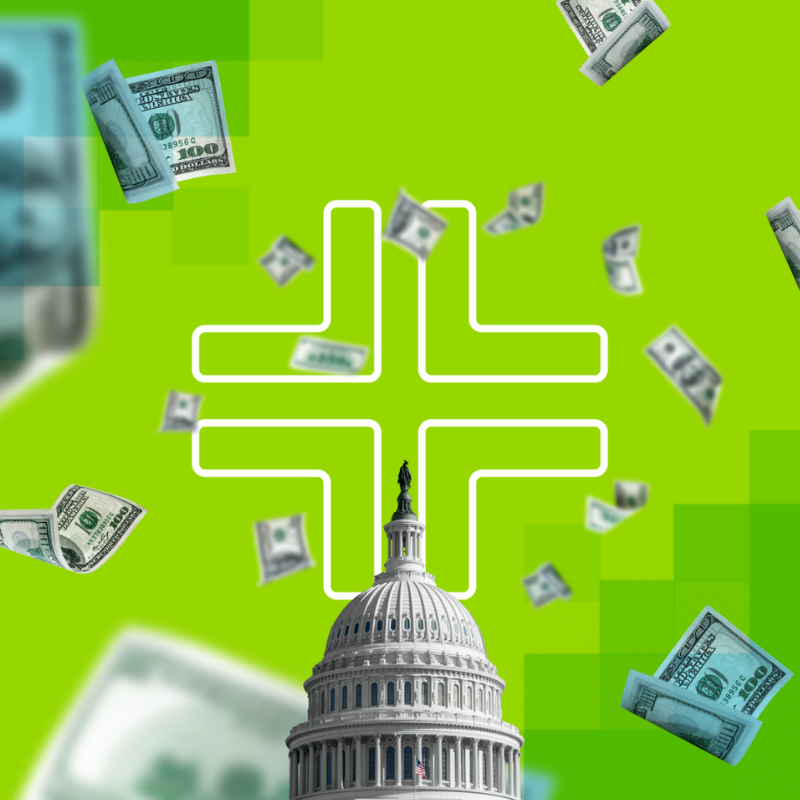The House of Representatives adopted the Senate Budget resolution in a razor-thin vote on Thursday, April 10, 2025, after thirty House Representativeswho identify themselves as “fiscal hawks” ultimately flipped for the promise by the Senate that they would look to cut $1.5 trillion. While the Senate and the House pledged their alignment at finding at least $1.5 trillion in spending cuts and savings, the Senate budget resolution agreed to by the House only requires $4 billion in spending cuts.
The House originally passed a more fiscally responsible budget resolution on February 25th. Under the House budget resolution, scored using the current law, the amount of deficit added to the federal budget over a 10-year period was estimated to be approximately $3 trillion. This included an increase in the budget of $4.5 trillion for federal tax reform but also a goal of $2 trillion in spending cuts, with specific instructions of cutting spending by $1.5 trillion. In fact, House Budget Committee Chair Jodey Arrington (R-Texas) stated the following in a press releaseon April 5 regarding the Senate budget resolution:
The Senate response was unserious and disappointing, creating $5.8 trillion in new costs and a mere $4 billion in enforceable cuts, less than one day’s worth of borrowing by the federal government…
Our nation’s debt and interest death spiral are well underway with world war levels of indebtedness and interest payments exceeding defense spending. We are at a fiscal inflection point and failure to rein in our runaway deficit spending and unsustainable debt could prove catastrophic for our economy, security, and global leadership.
Ultimately, the Senate budget resolution was passed by the House on Thursday by a vote of 216-24, with Reps. Thomas Massie (R-KY) and Victoria Spartz (R-IN) as the only Republicans voting against the resolution. Not only does the adopted resolution not include the significant budget cuts included in the House proposal, but it also allows for the use of the current policy baseline as a scoring method. While the Senate budget resolution reports an increase in the deficit of only $1.5 trillion under the current policy scoring method, in reality, the Senate budget resolution passed by the House impacts the Congressional Budget Office’s (“CBO”) 10-year budget project by an estimated $5,678 or $5,8 trillion based on the Bipartisan Policy Organization and Committee for a Responsible Federal Budget respectively. In total, this budget resolution will add $2.7 trillion more to the federal deficit when compared to the original House budget resolution.
Get the Latest Tax and Legislative Developments
Withum’s National Tax Policy and Legislative Updates Resource Center is your go-to source for timely updates on tax law and legislative changes. Our team is closely monitoring sweeping tax reform changes, shifting tariffs and tax industry updates, delivering in-depth analysis and actionable insights.
Regardless of the budget resolution passed by Congress on Thursday, the nonpartisan CBO leader, Director Phillip Swagel, has already warned that the federal budget is at a tipping point. The federal budget deficit totaled $838 billion in the first four months of fiscal year 2025. That amount is $306 billion more than the deficit recorded during the same period last fiscal year.
Sometimes, it can be hard to conceptualize such a large budget. But using a standard household budget illustrates that the math simply doesn’t work.
Currently, the 2025 CBO estimated federal revenue (which assumes the Tax Cuts and Jobs Act provisions will expire in 2025) is $5.163 trillion. Mandatory spending for the 2025 fiscal year is $4.3 trillion, discretionary spending is $1.848, and the net interest owed on debt is $952 billion. This creates an overall deficit of $1,865 trillion for the 2025 fiscal year.
How would the same budget look for an average family? Let’s assume the family collects W-2 wage income after tax of $200,000 per year. Mandatory spending would include mortgage interest, medical, food, credit card bills, electricity and gas of $166,570. In addition, there is discretionary spending that may include college tuition, vacations, and extracurricular activities $71,586. Lastly, to be able to pay for the expenditures that have been incurred in prior years and the present, a debt of $1.166 million is outstanding, causing an interest expense of $36,800 to be paid during the year. This ultimately results in a deficit for the household of $75,000, which will again require additional debt.
| 2025 US Federal Budget (billions) |
Household Budget | |
|---|---|---|
| Revenue | $5,163 | $200,000 |
| Mandatory Spending | $4,300 | $166,750 |
| Discretionary Spending | $1,848 | $71,586 |
| Net Interest Expense | $952 | $36,800 |
| Total Deficit | ($1,865) | ($75,000) |
And while many families would be extremely uneasy at this point with the family budget, it is not necessarily ruinous if there is a plan to decrease the family deficit and pay off the loans outstanding. But for the federal government, there is no such plan in the 10-year forecast, and the budget resolution just passed by the House makes it far more difficult.
Over the next ten years, without the existing budget resolution, the debt held by the public will grow over 73%. The current debt held by the public in 2025 is $30.103 trillion and is estimated to be $52.056 trillion in 2035. Using the previous household example, the household debt started at $1.166 million in 2025 and would increase to $2.106 million by 2035.
And we all know that when debt increases, so does interest expense. The net interest expense is expected to increase over 87% in the next ten years, with the net interest expense in 2025 being $952 billion and skyrocketing to $1.783 trillion by 2035. Again, using our household example, the interest expense would skyrocket from $36,800 to approximately $69,000. The increase in debt and net interest expense is not sustainable, and the only question is when will the bubble pop. The largest holders of US public debt are domestic investors, including the Federal Reserve, private institutions and individuals. However, foreign governments also hold a significant portion of the US debt, with Japan and China being the largest foreign holders.
While many small and family businesses across America require federal tax reform to ensure growth and transition, there is also the need for a functional federal government and a thriving economy for future generations. This will require a balance between fiscal responsibility and federal tax reform. The budget resolution passed by the House is based on a promise to cut significant spending, which may prove undeliverable.
This article was originally published by Lynn Mucenski-Keck in Forbes on April 11, 2025.
Contact Us
For more information on this topic, please contact a member of Withum’s Business Tax Services Team.
This article aims to provide an unbiased and balanced perspective. We strive to present factual information and avoid any partisan bias. We do not endorse or oppose any political figure or party. Our commitment is to neutrality and fairness, ensuring that our analysis is objective.




